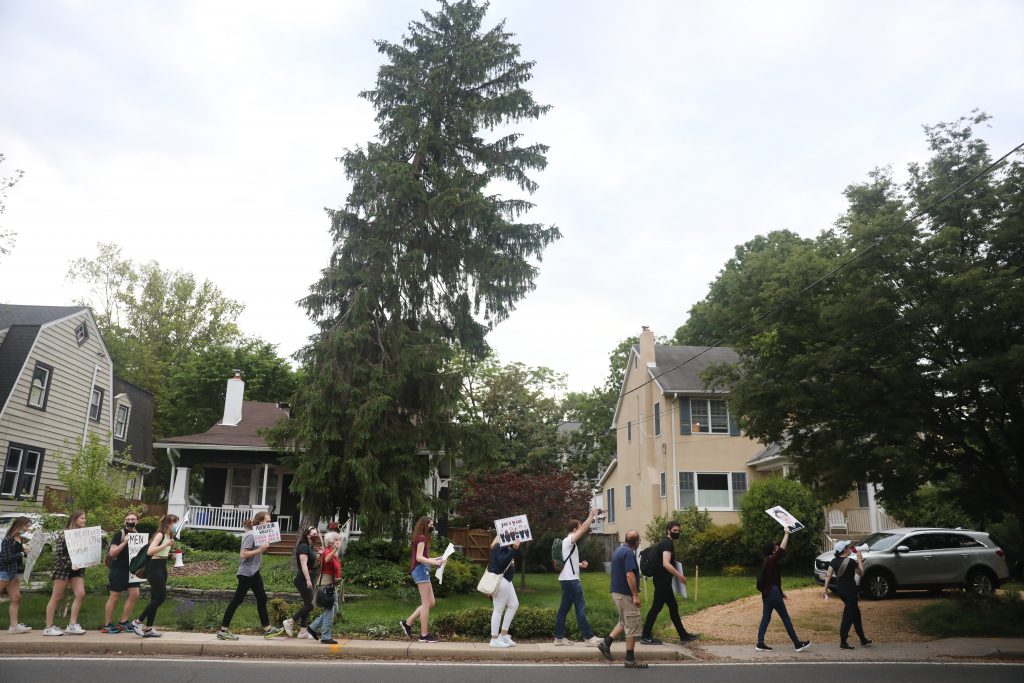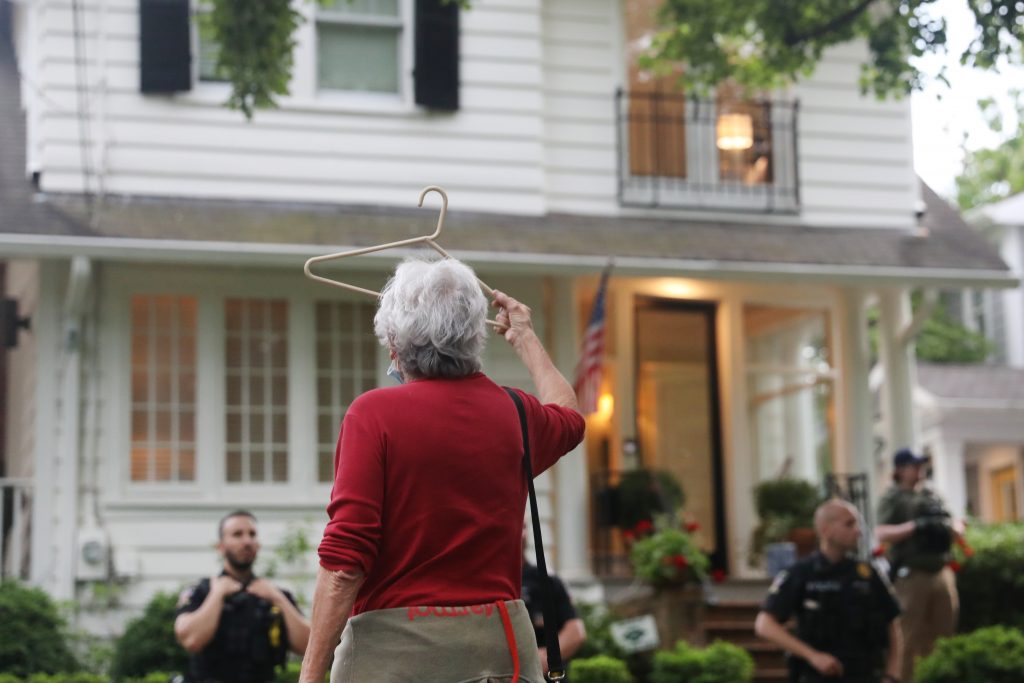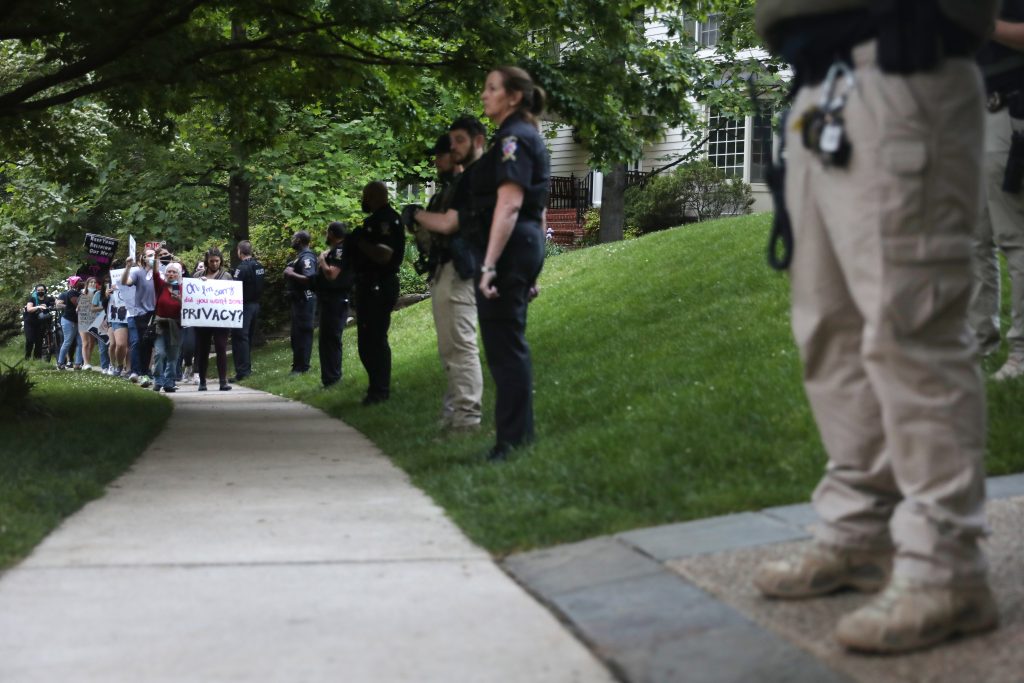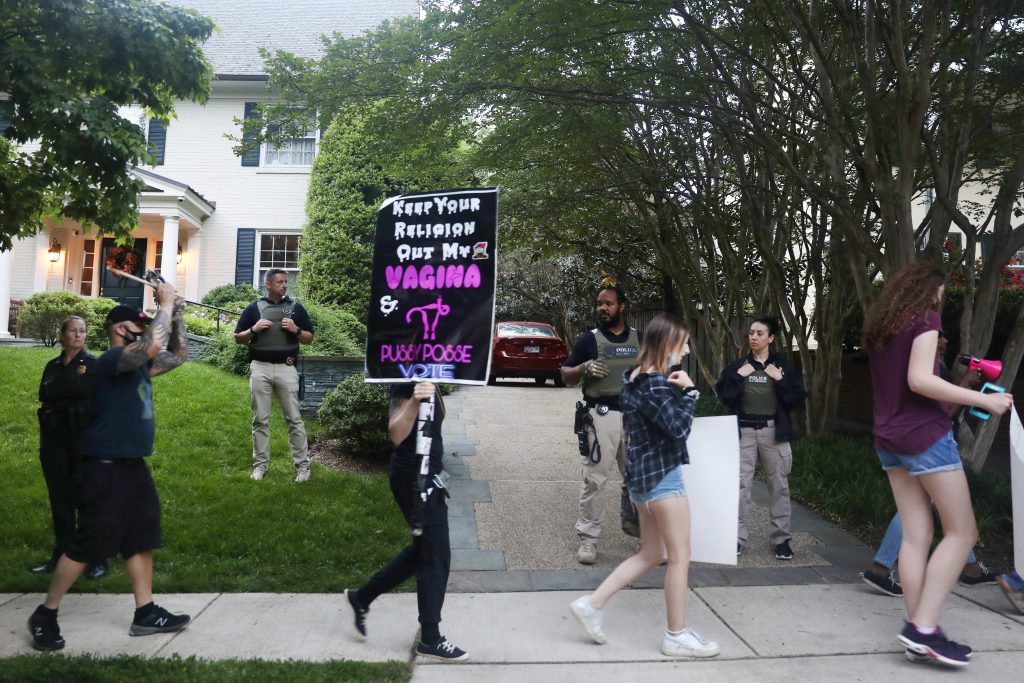Earlier this month, the U.S. news outlet Politico leaked an initial draft majority opinion written by Supreme Court Justice Samuel Alito. The draft, which allegedly had five votes needed to constitute the majority opinion, would strike down the landmark case Roe v. Wade. In 1973, Roe gave women in the United States the right to an abortion based on a constitutional right to privacy.
The leak immediately sparked widespread protests across the United States. In the aftermath, a new controversy arose: Is it legal to protest outside of the homes of the Justices that support the majority opinion?
Organized by his neighbors at Justice Kavanaugh’s house, demonstrators showed up with signs and shared stories of their abortions. At Justice Alito’s house, protesters with candles held a vigil. Despite the non-violent nature of these protests, the White House was swift to softly condemn them, stating that demonstrations should “never include violence, threats, or vandalism.” Senator Susan Collins called the police after protestors wrote pro-choice messages in chalk outside her home.

Meanwhile, the Senate quickly passed bipartisan legislation last Monday to extend security protections to immediate family members of Supreme Court Justices, citing a need to “ensure Justices and their families are protected from those who wish to cause them harm.” Two days later, the Senate failed to pass the Women’s Health Protection Act, legislation that would have codified Roe to protect women and all people who can become pregnant.
But the mere fact that direct action causes discomfort does not render it violent, and the fact that a large group of protestors gathers and chants or sings is not inherently threatening. Protesting outside the homes of the politically powerful is a tradition with a long and legitimate history. It is a valid form of direct action that should be respected, not stigmatized, by the White House, Congress, and law enforcement.
The history of protesting outside of the homes of public officials
Protesting outside the homes of public officials is a long-standing practice in the United States and worldwide and is widely viewed as a legitimate form of nonviolent direct action. In the modern era, the practice became popularized in Argentina in the context of denouncing members of the 1976-1983 military dictatorship after the return to democracy. The practice came to be known as escrache, a term signifying “to bring to light something hidden” or “to reveal what power hides.”
In particular, the practice was popularized by children of individuals who were disappeared during the military dictatorship. Over 30,0000 people were detained and then disappeared by the military dictatorship during the Argentine Dirty War. Some of the women detained by the dictatorship were pregnant at the time of their detention or became pregnant as a result of sexual assault committed by prison guards or police. One of the policies of the junta was to force these women to give birth while in detention. Their babies were then stolen and given to supporters of the regime. The women were killed or disappeared, never to be reunited with their children. This practice was so widespread that some clandestine detention centers had maternity wards where prisoners would give birth while shackled.
The escrache in Argentina was developed by some of these children when they grew up and learned the truth about their identities. Members of the organization would meet outside of the homes of members of the military junta and shout “asesinos” or “murderers.”
In a short film about escrache from the New York Times, one of the interviewees explains that the practice is “not about revenge” but “building this idea of justice, building this idea of anti-impunity.” These activists in Argentina refused to let the military’s violent deeds go unchallenged. Today, protestors all over the United States, including those who protest outside of Justices’ homes, express their outrage at a decision that would codify forced birth in the United States. They refuse to allow our rights to personal autonomy, privacy, and health to be stripped under the silence of civility.
In the United States, escrache also has a long history. It was a protest tactic used by pro-abolition youth movements before the civil war. In recent years, the climate justice movement has also adopted the tactic.
Peaceful protest includes disruptive protest
The escrache is a form of direct action designed to disrupt and create discomfort. However, the fact that a protest generates discomfort and disruption does not make it violent or illegal – practices such as escrache are legal under both U.S. and international law. International law is clear that disruptive and inconvenient protest is legal.
Articles 19, 21, and 22 of the International Covenant on Civil and Political Rights (ICCPR)–which the United States has ratified–codify the rights to freedom of expression, peaceful assembly, and freedom of association under international law. The fact that a peaceful assembly is controversial or causes disruption does not render the assembly violent or mean that it is not protected under the ICCPR.

The United Nations Human Rights Committee is clear:
“a ‘peaceful assembly stands in contradistinction to one characterized by widespread and serious violence. The terms ‘peaceful’ and ‘non-violent’ are thus used interchangeably in this context . . . ‘violence’ in the context of the article 21 typically entails the use by participants of physical violence against others that is likely to result in injury or death, or serious damage to property. Mere pushing and shoving or disruption of vehicular or pedestrian movement or daily activities do not amount to ‘violence.’”
Article 21, therefore, covers a wide range of protest activities, including those that activists are employing outside of Justices’ homes; it protects“demonstrations, protests, meetings, processions, rallies, sit-ins, candlelit vigils . . . flashmobs . . . [and] pickets.” There is a “presumption in favor of considering assemblies to be peaceful.”
Protesting outside of the homes of public officials is legal under U.S. law
U.S. law has similarly protected a broad range of protest activities, including those that cause disruption. For decades, the Supreme Court has allowed anti-abortion protesters to demonstrate directly outside abortion clinics. These decisions have led to the actual harassment of women seeking healthcare. Anti-abortion protestors regularly try to influence women against having abortions by threatening, assaulting,, and shaming them.
For example, the Supreme Court ruled that anti-choice protestors could demonstrate outside of the homes of abortion clinic staff, finding that a “300-foot buffer zone around staff residences sweeps more broadly than is necessary to protect the tranquility and privacy of the home.”
Why are Supreme Court Justices, public officials with a high-level national profile, afforded more protection against peaceful pro-choice protest than they have permitted to the employees of abortion clinics that have faced death threats and violence by anti-abortion demonstrators?

In cases of libel and defamation, the bar to overcome First Amendment protection is higher when the subject of the alleged defamation is a public figure. As the Supreme Court explained:
“Those classed as public figures stand in a similar position . . . For the most part those who attain this status have assumed roles of especial prominence in the affairs of society. Some occupy positions of such persuasive power and influence that they are deemed public figures for all purposes. More commonly, those classed as public figures have thrust themselves to the forefront of particular public controversies in order to influence the resolution of the issues involved. In either event, they invite attention and comment.”
Here, the Justices are certainly public figures. The court finds that public figures have less of a right to privacy in cases of defamation and libel because they have chosen to lead a public life. In the case of protests outside of homes, as noted above, the Court has found that citizens can protest outside of the homes of abortion clinic employees, who are private citizens. If public figures are afforded less of a right to privacy than private citizens, it follows that if protests outside of the homes of private citizens are legal, those outside of the homes of public figures necessarily must be as well.
Opponents of the protests have cited 18 U.S. Code §1507 to argue that protesting outside of Justices’ homes is prohibited. However, these arguments oversimplify the statute; furthermore, the statute itself may be unconstitutional. There are three reasons 18 U.S. Code §1507 likely does not provide a blanket prohibition on demonstrations outside of the Justices’ homes:
- First, the provision requires a showing that the protestors have the intent of “interfering with, obstructing, or impeding the administration of justice . . . [or]influencing any judge, juror, witness, or court officer, in the discharge of his duty.” It is impossible to impute intent on every protestor based on assumptions about the nature of the protest. Without an individualized inquiry, there is no way to know whether the individuals present at a protest have the requisite intent to influence the Justices or whether they are simply expressing frustration and indignation over what they see to be a foregone conclusion. The latter would not be prohibited by the statute.
- Second, the statute specifically only prohibits “picketing” and “parading.” These terms of art do not necessarily cover all forms of protest. A “vigil” on a public sidewalk or street, for example, is neither a “picket” nor a parade. Labor law, for example, distinguishes between “pickets” and “protests.” When protests outside of public officials’ homes became popular in Montgomery County in the 1980s, the Montgomery County Council banned picketing in residential neighborhoods; however, that ban did not prevent marching.
- Finally, 18 U.S. Code §1507 may well be unconstitutional. In United States v. Grace, 461 U.S. 171 (1983), the Supreme Court found that a statute that prohibited protests on sidewalks outside of the Supreme Court was unconstitutional. In that case, the government argued in favor of the law, specifically on the basis that picketing or marching “on the sidewalks at the edge of the Court grounds” could appear to appeal to or influence the justices and violate the independence of the judiciary. The conduct in question, therefore, was precisely what 18 U.S. 1507 prohibits on its face: protesting outside of a Court with the intent to influence a judicial position. The Court found that the “public sidewalks on the perimeter of the grounds” were in no way “different from other public sidewalks in the city.” Similarly, here, the protestors are situated on sidewalks and public streets. They are not located on the private property of the Justices’ homes. Under Grace, these actions are constitutionally protected.
It bears noting that anti-mask mandate protestors have also protested outside of judges’ homes. Some anti-mask mandate protestors even protested armed against mask mandates in Kentucky. However, there were no equivalent calls to criminalize these protestors under 18 U.S. § 1507.
Stigmatizing protest restricts civic space and puts protestors at risk
Recent statements from all three branches of our government have stigmatized protesters demonstrating outside of the homes of Supreme Court Justices. Government officials and the media have spread disinformation that the protests were violent, threatening, or dangerous, despite the absence of any evidence of such.
Around the world, we see how the stigmatization of protestors is used as a tool to restrict civic space and quash dissent. When public officials paint non-violent protesters as a threat, they open the door to justifying violence against them. This debate over tactics merely distracts us from the actual violence: the unnecessary death, trauma, and physical injury that will result from returning to a regime of forced birth.
Freedom of expression and freedom of choice are the cornerstones of human rights and our democracy. They should not be violated simply because they make those in power uncomfortable.

Kelsey Jost-Creegan is a staff attorney at EarthRights. Kelsey holds a J.D. from Harvard Law School and is an expert on corporate accountability, paramilitary violence, and forced migration in the Americas.





